
In September 2023, Grégory Schneider-Maunoury, a member of the SFAF and professor at Sorbonne Paris Nord University, presented the progress and results of his study "Indirect consumption: the scope 3 of water", carried out with DEFIS Masters students.
In this new era of sustainable finance, marked by numerous data collection initiatives, it remains very difficult to measure companies' indirect water consumption. Yet for 90% of the companies studied, their indirect water consumption is much higher than their direct consumption.
The aim of this study is therefore to provide an initial estimate of the indirect water consumption of listed European companies whose balance and production are based on agriculture.
Part 1 of the study deals with the lack of information on water consumption in sustainable financial regulations. Part 2 presents the methodology used and the estimates gathered from the data provided by the companies. Finally, Part 3 sets out the results obtained and proposes recommendations for further analysis.
All the tools needed for ESG and financial analysis do not yet fully integrate this essential component of nature: water.
CDP (Carbon Disclosure Project) has been a pioneer in this field, collecting data from a large number of companies since 2009 via the "CDP Water", a questionnaire to which 3,900 companies responded in 2023. Today, national (information on water consumption, abstraction and discharges is required within the DPEF) and European (information on water intensity and consumption is implicitly required in the CSRD, ESRS 3) regulations have taken over. However, they are showing restraint on the subject of water. Although the European Taxonomy(1) is concerned with the protection of this natural resource, no common international objective on water protection has been defined (unlike the issues of global warming or the protection of biodiversity, which have been addressed by the institutions for many years).
These texts do not deal with the estimation of indirect water consumption, as only the quantity or quality of water is mentioned ("sustainable use and protection of aquatic and marine resources"(2)). There is therefore a gap in the materiality of the impact of water, which is limited to direct consumption.
However, it is not impossible to measure indirect water consumption. A method has been developed (Chapagain & Hoekstra, 2004) to calculate the indirect water consumption for each plant or agricultural product. This method assigns an agricultural coefficient to each plant or agricultural product. It represents the quantity of water per product, generally expressed in liters/kilo (the sum of all the respective water requirements needed to manufacture a product).
The results of the study carried out by Gregory Schneider-Maunoury and his students show that, of the total water consumed by a company, direct water consumption represents only 0.001% to 1%. This result can be compared with the percentage of indirect greenhouse gas emissions (scope 3), which turns out to be much higher than that of direct emissions (scope 1).
Of the 27 companies analyzed, 5 do not provide sufficient information to enable an estimate of their indirect water consumption to be made, and 10 others share fragmentary information which hampers the quality of the estimate or the strategy. Only 2 companies, through their published data, allow the reader to understand the measures implemented to reduce indirect water consumption (choice of raw materials and their places of production).
Furthermore, the authors make 3 observations:
- It is necessary to encourage companies to publish estimates of their indirect consumption in order to gain a better understanding of direct water consumption;
- Estimating indirect water consumption enables a better analysis of a company's strategy for monitoring and reducing water consumption;
- Indirect water consumption is an example of materiality of impact: it does not directly harm the company, but it can lead to misuse of the resource in the country or countries where it is drawn on.
The presentation given on 7 September can be downloaded from the documentary database on the SFAF website (members only).
Also worth reading: the article "Indirect Water Consumption: The Scope 3 of Water ? Estimation of this Indicator in Sectors Relying on Agriculture" by Grégory Schneider-Maunoury.
(1) Regulation forming part of the European Green Deal and establishing a classification of environmentally sustainable activities.
(2) Regulation (EU) 2020/852 of the European Parliament and of the Council (article 9).
